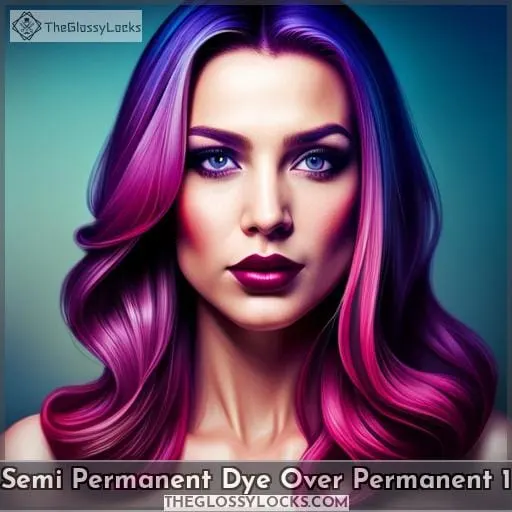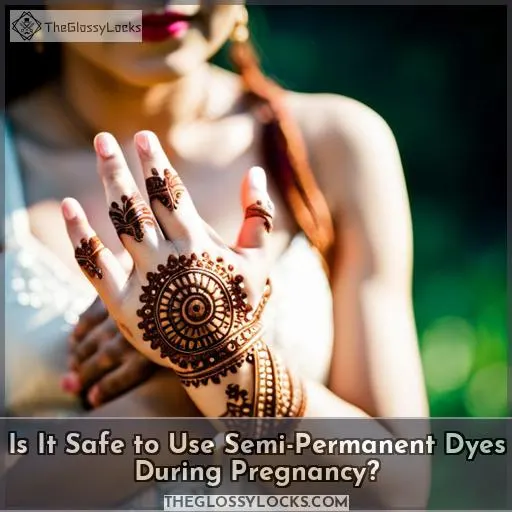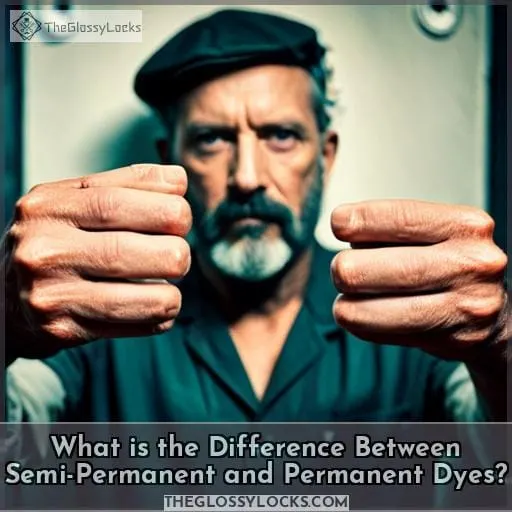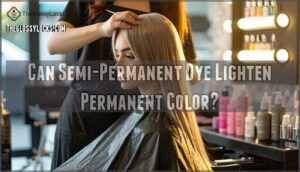This site is supported by our readers. We may earn a commission, at no cost to you, if you purchase through links.
 Hello! Looking to switch up the color of your hair with a semi-permanent dye, but it’s already been permanently dyed? You’re not alone.
Hello! Looking to switch up the color of your hair with a semi-permanent dye, but it’s already been permanently dyed? You’re not alone.
Whether you want to know how safe it is during pregnancy or if it can lighten permanent colors, this article will give you all the information that you need. So don’t waste any more time trying to guess what might work – get all of your questions answered in one place so that you can make an informed decision about which type of hair dye works best for you.
Table Of Contents
- Key Takeaways
- Can I Apply Semi-Permanent Dye Over Permanent Color?
- How to Bleach Permanently Dyed Hair?
- Is It Safe to Use Semi-Permanent Dyes During Pregnancy?
- What is the Difference Between Semi-Permanent and Permanent Dyes?
- Can Semi-Permanent Dye Lighten Permanent Color?
- Do Semi-Permanent Dyes Cover Gray Hair?
- Frequently Asked Questions (FAQs)
- Is it safe to bleach over henna-treated hair?
- What is the best way to prepare hair for semi-permanent dye over permanent color?
- Are there any special precautions that need to be taken when applying semi-permanent dyes over permanent color?
- Does bleaching over henna-treated hair have any risks?
- What are the best semi-permanent colors for hair with henna deposits?
- Conclusion
Key Takeaways
- Semi-permanent dye can be applied over permanent color, but the results may vary.
- It is recommended to wait for the permanent hair color to fade or wash out before attempting any bleaching process dyeing fine hair gently.
.
- Using bleach over pre-existing dyed hair may result in red undertones.
- Henna deposits should be bleached or faded before applying semi-permanent dyes.
Can I Apply Semi-Permanent Dye Over Permanent Color?
You may be tempted to switch up your look, but applying semi-permanent dye over permanent color can create unexpected results. In most cases, it is necessary to wait for the permanent hair color to fade or wash out completely before attempting any bleaching process.
The Paradyes Lighten Up Bleach Kit is a great option for lightening hair up to 6 levels. However, this result will vary depending on an individual’s hair texture and porosity. It should also be noted that when using bleach over pre-existing dyed locks, red undertones may appear as an outcome due primarily to the multiple layers of existing pigment already present within the strand itself.
When dealing with henna deposits in one’s hair, it is not recommended to apply semi-permanent dyes directly without prior bleaching or fading procedures. This could cause orange undertones if done incorrectly. For those who have previous henna applications on their hair, it is advised to wait at least six months before trying any other coloring services.
Warm tones like purple, pink, and even oranges are typically preferred options here, rather than going straight into a complete 180 change with cold colors such as blue/greens, etc.
Bleaching, though, depends very much on each individual’s hair. So, results could alter drastically between individuals, no matter what method you use! If you are still uncertain about whether you should go ahead and apply semi-permanent dye over previously dyed locks, please feel free to ask questions through Instagram or join #ParaFam – our wonderful community dedicated to helping others reach their maximum potential beauty goals!
How to Bleach Permanently Dyed Hair?
For those looking to switch up their look, bleaching previously dyed locks can be a daunting task. With permanent hair dyes changing the natural pigment of your strands and henna deposits lingering in the background, it’s important to take into account any risks that come with lightening before you begin.
Understanding hair porosity will help determine how much color will lift and what tones may surface after processing.
The Paradyes Lighten Up Bleach Kit has had great success in lifting up to 6 levels of pigment from pre-existing dye jobs. However, results still vary depending on each individual’s unique texture type and porosity level.
In terms of avoiding red undertones from forming within the strand itself due to multiple layers already present prior to bleaching, try using toners or glosses post-process instead. These can help neutralize any unwanted shades popping through unexpectedly upon rinsing off product residue afterwards.
Lastly, but certainly not least, if all else fails, don’t hesitate to reach out via Instagram or join the #ParaFam community page where others like yourself, who understand these dilemmas firsthand, might just provide some helpful advice along the way during this journey towards achieving desired results!
Is It Safe to Use Semi-Permanent Dyes During Pregnancy?
It’s important to consider the safety of using semi-permanent dyes when you’re expecting, as some chemicals can be harmful for your baby. While permanent dyes are not recommended during pregnancy due to their toxic effect on unborn babies, there is an alternative option for those seeking temporary coverage or color change without compromising health.
Mindful dyeing with natural ingredients and semi-permanent colors provides a safe way to get creative while pregnant – plus they won’t damage hair like professionally applied permanent dye!
The key here is that these products don’t penetrate the cortex layer of the hair strand in order to alter its natural pigment, meaning they cannot have any negative effect on unborn children either.
When picking out shades, it’s beneficial if one does research beforehand so as not to suffer any regrets afterwards. Because once dyed over previously colored strands (i.e., already professionally done), there could be unexpected results which may require further processing down the line – something best avoided while pregnant altogether really! And this same concept applies also when henna deposits are present.
Warm tones like purple, pink, orange, or red work well paired with bleaching, but never attempt applying bleach directly over, especially since it may result in orange undertones surfacing after rinsing product residue off later instead of what was originally intended initially.
Lastly, make sure to always follow instructions carefully every step along the way before committing yourself wholeheartedly into the project, as mistakes made during the process can still end up being costly, even if risks involved were minimized ahead of time thoughtfully enough already beforehand yet again.
What is the Difference Between Semi-Permanent and Permanent Dyes?
Now that you know the difference between semi-permanent and permanent dyes, it’s time to learn about the best bleaching techniques for achieving optimal results. Bleaching is necessary when applying semi-permanent hair colors over permanent dyes or henna deposits so as not to cause any damage while still providing a desired change in color.
It should be noted that results may vary depending on hair texture and porosity. Paradyes Lighten Up Bleach Kit is able to lift up your locks by 6 levels at most.
Henna treated hair requires extra caution when using a bleaching agent. Waiting at least 6 months for all traces of henna coloring agents to wash out completely before attempting any such venture would be highly recommended here too.
As far as what colors work best once bleach has been applied successfully? Warm tones like purple, pink, orange, or red usually perform splendidly since they complement underlying natural pigment effortlessly without having an adverse effect whatsoever from long term use either.
Ideal choices really then considering how common this type of situation can become nowadays in general indeed.
Can Semi-Permanent Dye Lighten Permanent Color?
You can’t take the dye out of dyed hair–but you can try! Applying semi-permanent color over permanent dyes or henna is tricky business, so it’s best to proceed with caution and don’t expect miracles.
If your goal is to lighten a previously dyed head of hair, there are some key points you should consider before embarking on this process. First off, research the manufacturer’s instructions for their permanent dyes in order to get an idea as to what techniques they recommend when using semi-permanent colors afterwards.
Generally speaking though, bleaching will be necessary for optimal results although it may only lift your locks up by 6 levels at most according to Paradyes Lighten Up Bleach Kit specifications—results could vary depending on texture and porosity too mind you!
Furthermore, if any traces of Henna coloring agents remain, then these must be removed prior through washing them out completely. This process takes around 6 months minimum ideally before starting anew here also.
Otherwise, orange tints might emerge instead due to its presence, so keep that in mind too.
Lastly, when selecting colors afterwards, warm tones like purple, pink, or red usually work well since they enhance natural pigment without causing damage from prolonged use either. This makes them a healthier choice overall, really, given how common such dilemmas have become nowadays anyway all things considered.
Do Semi-Permanent Dyes Cover Gray Hair?
With gray hair, you can try semi-permanent dyes to cover it up and brighten your look. Depending on the type of dye used and the color of the hair, this process may be simple or require a more complex bleaching process.
Having an understanding of different types of dyes as well as one’s own hair type is essential for achieving desired results with any dyeing process. Firstly, permanent colors are not recommended to be applied over henna deposits since they will interfere with its natural pigment while also resulting in orange undertones due to chemical reactions from both components when mixed together.
Alternatively, using warm tones like purple, pink, orange, red, etc., is advised since these have less damage potential when compared against blues or greens which tend to disrupt melanin levels within our hairs making them brittle in return eventually too!
Lastly, regardless of whether opting for those colors above or something else altogether, still remember that bleaching might become necessary if any traces remain from previous coloring treatments prior—so best keep that possibility open beforehand either way before committing yourself here then yes?
To summarize: Semi-permanent dyes provide a great option for covering gray hairs without worrying about damaging underlying strands underneath through their delicate composition so long as appropriate precautions are taken first (i.
Frequently Asked Questions (FAQs)
Is it safe to bleach over henna-treated hair?
It is not recommended to bleach henna-treated hair as the results vary depending on individual hair type and porosity. Bleaching may cause orange undertones, so instead, opt for warm tones like purple, pink, or red.
What is the best way to prepare hair for semi-permanent dye over permanent color?
To prepare your hair for semi-permanent dye over permanent color, it’s best to wait until the existing dye has faded or washed out. Consider bleaching if necessary; however, this may result in red undertones depending on the layers of previous coloring.
Avoid using semi-permanent dyes over henna — instead, opt for warm tones like purple, pink, and orange.
Are there any special precautions that need to be taken when applying semi-permanent dyes over permanent color?
Yes, there are special precautions when applying semi-permanent dyes over permanent color. Bleaching is necessary to lift pigment and may result in red undertones. Henna should be avoided or wait 6 months before bleaching; warm tones like purple, pink, and orange are recommended instead.
Does bleaching over henna-treated hair have any risks?
Yes, bleaching over henna-treated hair can carry risks. It may result in orange undertones and not produce the desired effect due to individual hair type. Wait 6 months for henna to wash out before attempting it, and use warm tones like purple or red instead.
What are the best semi-permanent colors for hair with henna deposits?
For hair with henna deposits, warm tones like purple, pink, orange, and red are recommended. Experiment to find the perfect shade that works for you! Be sure to wait 6 months for henna to wash out before applying bleach or semi-permanent colors.
Conclusion
It can be tricky to apply semi-permanent dye over permanent, but with the right knowledge and techniques, it’s possible. Bleaching is the best way to lighten the hair and create a better base for semi-permanent dye.
However, it’s important to be aware that the results may vary depending on the type of hair and the number of layers of permanent dye or henna. If you’re wondering if semi-permanent dye is safe to use during pregnancy, make sure to consult with your doctor before using any products.









